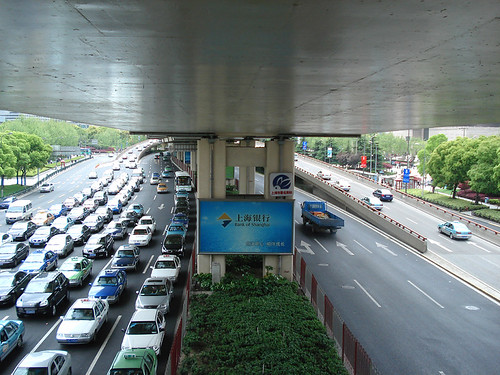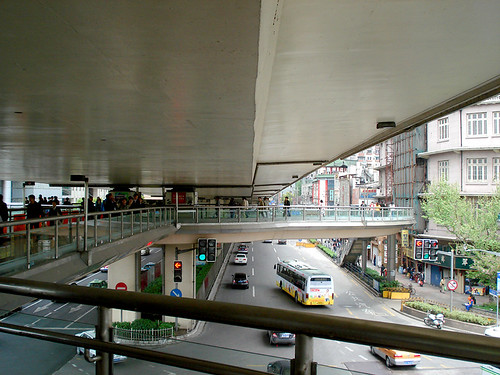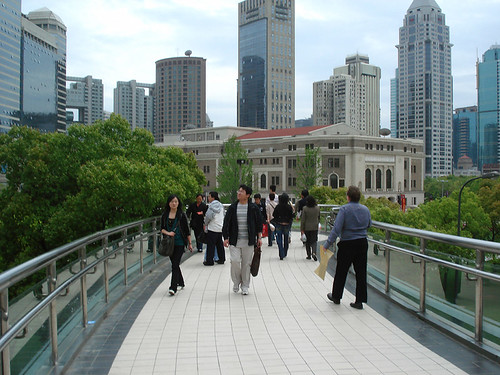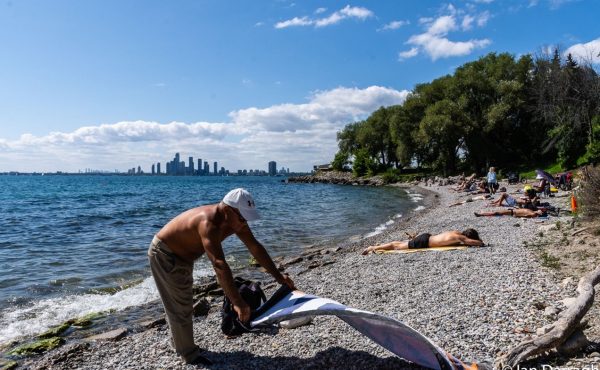
View from pedestrian bridge under Shanghai elevated highway, but above Lake Shore Blvd.-style road
The recent decision by city council to begin the environmental assessment of the partial take-down of the Gardiner Expressway should encourage all of Spacing’s readers to consider the variety of the options available to the city.
Many readers have said the true barrier to the waterfront is not the Gardiner itself, but the six lanes of Lake Shore (to be perfectly honest, I don’t buy into that notion, but I certainly recognize it as part of the many barriers that exist). So when Graeme Stewart of ERA Architects showed me a handful of images of Shaghai’s elevated expressway, I was surprised to see it shared some similarities with our Gardiner.

What was most intriguing were the elevated pedestrian bridges that arched over the 8-lane road that exists under the highway. While I’m more in favour of taking down the Gardiner than legitimizing its existence with a band-aid solution like pedestrian bridges, these images show that if the decision is made to keep the Gardiner intact in the central waterfront (where it *really* needs to come down), than maybe creating these safe passages for pedestrians is where Toronto needs to be heading.


photos by Graeme Stewart




30 comments
I don’t think that Pedestrian bridges would work, the Gardiner may not be high enough in spots, you need at least 2m below The Gardiner for the bridge to be useful, and you still need over 4.5m from the surface to the bottom of the pedestrian bridge. I think what is quickly becoming the biggest impediment to the waterfront, is that there is now a wall of condominiums at the waterfront, so much of it is no longer accessible.
I still think the real solution for the city, in regards to the Gardiner would be to close that section for a year, For $50,000 worth of barricades, you could find out if it’s sensible, without spending millions of dollars on environmental assessments and demolition, all to find out you really need the traffic space after all.
One figure the city needs to remember is $14.5 Billion, this is what it cost Boston to bury their version of the Gardiner.
Glad to see this alternative model posted for elevated throughfares. This looks a hell of a lot more pedestrian-friendly than any 6 or 8 lane replacement road that is being contemplated. Tearing down the Gardiner may be a good thing, but I think a lot more honest analysis is needed regarding what the outcomes will be, rather than just ideological head butting. I think too many proponents of the tear down option are being seduced by a vision of added waterfront access that will simply not materialize given the proposed expanse of the replacement road and the wall of condos that will be put up. The big question, though, is why the city is talking about tearing the Gardiner down now before it has developed a proper transit plan to address capacity in these areas. Give people adequate transit and the need for the Gardiner may evaporate altogether eventually. But as things now stand, the transit system is woefully inadequate.
Sorry Sam, but there is a transit plan for the area, but more work/study needs to be done in that area. Saying it doesn’t exist is totally inaccurate.
I doubt this is more pedestrian friendly than tearing down. I’d rather cross 8 lanes of road with no highway above than 6 lanes of road and an elevated highway above. Dark, dank spaces are much more hostile than 2 more lanes of road.
two points – with the above, sam was just saying there’s an inadequate transit plan, and he’s quite correct.
It’s not just peds that need consideration, these under and over-passes need to have good room for bike lanes too, as it can be daunting doing these north-south routes with one lane leaving to a usually no-go zone for bikes and other taxpayers. It’s okay when the mobile furnaces are slowly frying the planet, but when the traffic is lighter, it’s kinda dangerous.
Also notice here, the relatively “clean” aesthetics of the Shanghai highway: smooth concrete underside, etc. Short of a total rebuild, I’m not sure if the Gardiner can accomodate such pedestrian intertwining, because it wasn’t designed to be experienced “up close” like that…
That would be a wicked cool idea.
I’m surprised that it hasn’t been done already here by now (and then I remember I live in Toronto, home of the endless waste of time studies and stalling tactics).
I gather this is going to be another of those posts, now at least 10 in number, in which you fail to disclose that ERA Architects is your part-time employer.
Or is that no longer the case?
Was it the case when the many, many previous posts mentioning ERA went up?
Wogster: How are condos a barrier for pedestrians? If anything, they make the neighbourhood safer and more pedestrian-friendly by making sure there’s always someone around, that there are local sources of food, and so on.
Some waterfront rail lines being removed too!
A press release was issued by Cityhall this afternoon with great news for bicyclists and pedestrians on the waterfront. Find it below.
TORONTO ECONOMIC DEVELOPMENT CORPORATION
media release
Toronto – July 17, 2008: TEDCO and Redpath Sugar Agree to Improve Public Realm
The Toronto Economic Development Corporation (TEDCO) announced today that it has entered into an agreement with Redpath Sugar Ltd. to end its lease of TEDCO’s railway lines along Queen’s Quay Blvd. East.
Redpath agreed to give up its lease of the railway lines in a generous effort to support the City of Toronto and all potential users of the waterfront. With the railway tracks removed, the eastern portion of Queen’s Quay Blvd. will become more accessible to bicycle paths, be more pedestrian-friendly and remove barriers for redevelopment along the waterfront.
As part of revitalization of the surrounding area, Redpath Sugar will remain part of the City’s mixed-use waterfront as reflected in the Central Waterfront Plan confirmed by City Council. This agreement allows further redevelopment of the East Bayfront area to proceed and will also help accommodate the new Jarvis Slip park to be named Sugar Beach.
“With this agreement TEDCO continues to help make revitalization of the waterfront a reality,†said Jeffrey Steiner, President and CEO of TEDCO. “Part of the dynamic of a mixed-use waterfront is the fact that we have active, interesting and productive employment uses in close proximity to institutional, residential and commercial development.â€Â
Jonathan Bamberger, President of Redpath Sugar Ltd. said, “We have worked hard with TEDCO to ensure the development of a vibrant waterfront as well as the continuity of our business. Losing the rail line is not positive for us but we felt the benefit to the City outweighed our concerns. We believe that this agreement is in the public interest and hope that careful thought is given to the interface of different types of waterfront users.â€Â
“The city’s precinct plan did not specifically call for the removal of the rail lines so Redpath has been a good and cooperative corporate citizen in contributing to a better public realmâ€Â, TEDCO’s Steiner added.
The East Bayfront area consists of a mix of public and private land between Jarvis Street and Parliament Street, south of Lakeshore Blvd. The area will be transformed into a mixed-use community with employment, institutional, cultural and residential uses as part of a precinct plan developed by Waterfront Toronto.
TEDCO’s Corus Entertainment office and broadcast building is currently under construction just south of Queens Quay East which will employ more than 1,300 knowledge workers with occupancy slated for the fall of 2009.
TEDCO is the principal redevelopment corporation for the City of Toronto focused on commercial, industrial and mixed-use projects. Incorporated in 1986 as an Ontario Business Corporation, TEDCO plays a key role in brokering private and public sector partnerships to advance city building initiatives.
-30-
For more information:
Eva Varangu
Director, Communications & Public Affairs
Toronto Economic Development Corporation (TEDCO)
416.981.3869
evarangu@tedco.ca
http://www.tedco.ca
I wish I could remember the name of the street, but there’s a large, busy street, much like Lakeshore, in Ginza, Tokyo that deals very well with pedestrian traffic too. There are not only above-ground ped bridges (with escalators!), but they run the road underground in places as well.
No, it really is street level traffic that’s the pedestrian barrier. That’s an observation, I’ve walked under elevated highways without a Lakeshore underneath and it’s easy as pie. I reguarly cross the Gardiner-free Lakeshore at Leslie and ride the bike path, and it’s difficult and somewhat dangerous, like walking in Scarborough. If you’re walking to the lake, expect long light cycles and being trapped on the median if they don’t intend on delaying car traffic more than 4 minutes. Pedestian bridges are OK as long as they happen to be where you need to cross but it’s still coralling pedestrians to suit drivers.
The condos are a visual barrier. Thus, removing the gardiner will not help the view.
Joe: since the Shanghai pedestrian bridge is not a project of ERA, nor does ERA have anything to do with the topic of the post, I have no idea why I would need to declare anything. Graeme, while on vacation, was nice enough to send me some photos he thought I’d be interested in. I thought it would be nice to give him credit. Anyone can click on my name and read my profile which includes a mention of my ERA gig. And I’ve only done one post — on May 12th — that mentions ERA and it came with a disclaimer. It’s always nice to come home to see comments that are trying to smear me. But thanks for trying.
Here’s an idea (not saying it’s a good one, just a suggestion).
Leave the Gardiner up.
Lower the Lakeshore (drop it down about 6-10 feet, and put up railings so people don’t fall in.
Build pedestrian bridges over top.
This way, you could probably keep the level of the pedestrian bridges close enough to the level of the surrounding area that you could make them wheelchair accessible with ramps.
Interesting idea. Throw me in the camp of people who aren’t convinced taking down the Gardiner is the right strategy for reducing barriers to the waterfront, but I think bridges like this would be useful as crossings over the rail tracks at roads like John or Portland.
Funny, I was thinking about this the other day. I was daydreaming about taking down the Gardiner, but having pedestrian bridges over the lakeshore instead of level crossings. I think the key to success would be to have very wide crossings, with landscaping and even space for retail along their length. Otherwise these spaces could feel kind of creepy and unpleasant.
Argh, again with the “wall of condos”. I really, really try hard not to be civil but I am tiring of repeating this: the street grid provides access and views to the waterfront. Not buildings. It doesn’t matter if the condos are condos 2, 8 or 50 stories – they are all equivalent in that are going to exist on these things called “lots” and they would all block the view in flat Toronto. The greatest urban waterfronts in the world still have buildings along them (hence the word “urban”). Unless you are advocating that a massive park the size of the Toronto Islands be created below the Gardiner, it makes no sense to complain about the buildings. Complain about the streets – how they must pass under road and rail lines, how there are not enough north-south routes between Jarvis and Spadina, how the streetscapes are barren and depressing. The condos are not your enemy.
As for Lakeshore, it’s just a design puzzle. I’m sure you would all drool to have the waterfront that the west side of Manhattan has. This once was identical to the Gardiner but today features a surface road that carries more traffic volume than Lakeshore yet has no highway overhead, has frequent crossings, the curbs are granite, the lighting is retro, the landscaping is lush and it includes an awesome, segregated bike speedway. Bridges are not used except at a couple tourist points (Intrepid, WTC) because people tend not to use bridges.
It’s a big world, and other cities have already solved these problems. Learn from them.
Oops – was originally trying to say “try hard not to insult people”, meant to change to “try hard to be civil”.
I have not understood the “wall of condo” thing either. There are some **ugly** ones down there. But whose view is being blocked? People on the 14th floor of the Royal York?
I live and work near the part of the Gardiner the proposal is studying, and I walk under the Gardiner to my job every day. Granted the Gardiner is an eyesore and generates a HUGE amount of noise and pollution in the immediate area, but as a pedestrian it does not impede my access to the waterfront at all. The bigger obstacle is the two-stage light system needed to control traffic on Lake Shore Blvd. and that road itself. I’ve lost count of the number of times I have been crossing on my signal and had to jump out of the way of a car racing on or off the Gardiner because they thought they should have their light but are unfamilar with the light patterns.
As an area resident and pedestrian my suggestion is this: Leave the Gardiner up and either narrow Lake Shore Blvd to get rid of the two-stage traffic light system and/or build a pedestrian tunnel or bridge so that we can bypass it entirely.
I’d advocate for tearing up Lake Shore Blvd entirely, but that would probably just shift more traffic to Queen’s Quay, The Esplanade and Front Street, which would be even worse.
I agree with Sabrina, long light cycles are the hidden barriers on wide streets.
Something just occurred to me that from an emissions perspective, isn’t it better to keep traffic moving than have it stop at a series of lights?
I’m firmly on the side of keeping the Gardiner up. This post, posts I’ve made about various other cities that integrate elevated things into the city by building the city up and under it, suggest to me there are many other solutions than making an extremely wide street that is slow to cross.
re: Redpath
First off I hope they pull *all* of the rail out of the ground – I find the practice of tarring over rails very annoying here because it wears off and is not properly maintained.
Where do the trains that bring stuff to Redpath originate from? I imagine it will generate a lot of additional Queens Quay/Lakeshore truck traffic to move what is currently being moved by rail, not least now the Gardiner may come down. A bold step would be to refit some of the 250+ CLRV/ALRVs due to be retired if TTC gets its act together as cargotrams to bring Redpath goods to/from a railhead along the Queens Quay East ROW off peak, since cargo doesn’t worry about low floors.
“Give people adequate transit and the need for the Gardiner may evaporate altogether eventually.”
The end of cheap gas may also have that effect and sooner than we might like to think. It would also make transit improvements absolutely necessary.
In London, there’s an elevated expressway called the Westway and a land development corporation controlled by community groups has put the space beneath it to all sorts of interesting uses — soccer fields, light industrial, generic buildings, etc. They serve a fairly diverse community on either side. Point being that the problem with the Gardiner, as John van Nostrand and Calvin Brooks have argued in their alternative vision, isn’t the Gardiner but Lakeshore. If you move Lakeshore and make it into a real street, then one could use the space beneath the Gardiner for other urban purposes, including all the quotidian uses that Waterfront Toronto’s planners will no doubt overlook.
The other point is that with more and more people living and working between the rail corridor and the lake, there is increasing pressure on the city to deal w/ pedestrian issues at grade. A decade ago, you’d hardly see people crossing Lakeshore. Now there’s a steady stream. And so all of these sentiments bubble to the surface.
Re the “wall of condo” thing, I think the real problem there isn’t the condo aesthetic, but the Lakeshore/Gardiner elevation aesthetic–that is, these edifices turn their backs to that particular transportation corridor, because who’d want to live (or stroll, or window-shop) facing it? Thus, if you remove the Gardiner where the condos already exist, you’ll have a grim, unsightly back-alley situation–redefining this whole “wall of condo” bugaboo.
There’ll have to be plenty of urban remediation to make the Lakeshore urbanistically pleasant once the Gardiner’s gone, and I don’t just mean regarding the roadway proper.
Mark: The Redpath rail is a reserve line. The vast majority of their stock comes in by boat, and then by truck when the harbour is frozen.
As Toronto contemplates tearing down its elevated highway, Tampa Florida is building one: http://tinyurl.com/6lzws9
So the Scarborough expressway (or whatever it was called) was torn down and this resulted in, partly, a Canadian Tire, a possible Wal-Mart, and a very unfriendly road for pedestrians – what is the $300+ million here going to do?
While I do not wish that particular highway had stayed up and I would love it if the Gardiner, as well as Lakeshore, did not exist, $300 million for like three blocks of no elevated highway + a busy, wide, street-level road + a dark crossing under a very wide section of rail tracks just does not seem worth it.
If they cannot think of a better plan, why not just keep the damn thing for those few blocks and spend the money on improving the streetscape – with something as simple as the double-light thing. It just seems that planners in Toronto can generally be characterized as incompetent and not much beyond that.
Sanju,
You’ve said a mouthful. The section between Carlaw and Leslie? was taken down some time ago — and I agree that it should have because it was hard to understand why this section was elevated given volume and where traffic was headed. But the change doesn’t really seem to have accomplished much in terms of waterfront access. And the area seems as industrial and desolate as ever. Also, from a pedestrian point of view, that wide expanse of road ground level is very forebidding given the volume and speed of the vehicles. The only pedestrians I ever see at those intersections are panhandlers. (Am not counting rollerbladers and joggers.) I am not a proponent of keeping any part of the the Gardiner. But I also think it would be a bad move to make a change that results in a heavy, constant flow of fast moving traffic (or congestion) around the foot of Jarvis that is trying to go further east or connect to the DVP. Such a move doesn’t do anything for the environment…especially if no “adequate” transit plan is in place or being undertaken. (A bureaucrat will always say there is a plan — or strategy — in place…the question is whether it can bear scrutiny.) Regarding the “wall of condos” comment, I am not against condo development; the point I thought I was making is that these represent “private” as opposed to “public” spaces for the most part, and hence many consider them a barrier, especially if public space in the area is kept to a bare minimum. That’s probably why many of the most exciting civic waterfronts are overwhelmingly given over to civic space. Anyways, that’s the end of my rant on this issue. Whatever happens, I hope city officials will look honestly at what these changes will mean, not just for this corner of the city, but for all Toronto as a whole and the whole GTA.
I was at the very spot where these pictures were taken just last October.
This is at an extremely busy intersection downtown Shanghai and these walkways let people cross the intersection crosswise and diagonally. This is an unusual spot and in no way does it apply to the Gardiner where the foot traffic is less dense and occurs at multiple spots.
While I don’t believe the Gardiner should be taken down, and have yet to hear anyone actually explain how “it cuts the city off from the lake”, I think the focus of the debate must be on what we’ll have when and if it’s gone. Framing the debate on the negative concept of demolition is a smokescreen, distracting us with traffic timings and volumes, the semantics of ‘blocking access’ and the ideology of expressways.
If we’re actually going to get anywhere we must choose between the knownâ€â€an elevated road once an esthetic and engineering triumph, long-neglected and suffering but still doing known work at known costs versus what? We need to insist that the planners detail the new roads that will add “just two minutes” travel timeâ€â€obviously no waiting for turns at the many stoplights is contemplated. What will the neighbourhoods flanking this 12 lane road look like? How will they be more pedestrian/bike/transit friendly? How will we cross the Don? If the present Lakeshore makes getting to the water difficult, how will adding traffic and rebuilding it make it easier?
These are hard, hard questions, and it’s no wonder the planners have taken the easy way out, doing an EA on the ‘simple’ issue of demolition, leaving the shape of the new Grand Road TBA. Once we’re stuck without the crosstown expressway, we’ll readily buy into whatever is proposed to solve the resulting gridlock.
But letting those in power take the easy way out is not how great cities get built. If their vision isn’t great enough to sell, then we should tell them no thanks, according to the Better the Devil you know…Principle. These are bright, creative people, if we demand great things of them they can deliver, but their current effort: Tear it down, is no great thing. In fact it’s very close to a scam.
I am very concerned about the potential removal of part of the Gardiner Expressway.
I travel a lot with business, and do business in Toronto and around the world in the film and television production sector. My travel and work in other cities has allowed me to see how many other world class cities cope with issues such as transportation, and I have seen many creative solutions to problems that we have here in Toronto.
Keeping cross-town car and truck traffic away from pedestrian traffic makes a lot of sense. My crews and I are on the road in-town quite a lot, picking up and delivering supplies and building sets all over the city. The Gardiner expressway helps our efficiency and economic productivity in many ways, and helps to reduce pollution by minimizing idling at traffic lights and keeps those nasty traffic fumes above the pedestrian grade. It is MUCH faster than the lakeshore at most times of the day. Removal of the Gardiner would be a severe economic blow to our productivity and our ability to effectively do business here. The traffic problems here are already difficult to deal with. The gridlock caused by removal of this section would certainly convince me and likely others to take film and television productions to other cities. I’m sure that my industry is not the only one with these concerns – one must take into account that commuting into and out of the city is not the only way that the Gardiner is used.
The Gardiner has been called a barrier to the waterfront, but I firmly believe that an 8-lane road filled with idling cars and trucks is a much more significant barrier to the waterfront. Moving the “only” 120,000 vehicles per day that use that section of the Gardiner down to a grade-level street will be a huge step backwards for the environmental, cycling and pedestrian friendly movements in Toronto. The Waterfront Toronto study is obviously biased, and I would argue totally deluded. It argues that the new plan would add 2 additional minutes on the trip from Jarvis to Carlaw, which is ridiculous. You hit one red light and it’s more than that.
What we need to do is start developing the land under the Gardiner to be more appealing. Many cities around the world have developed their under-expressway spaces to be cafes and retail spaces, making a “useless” and “ugly” space into a useful and welcoming space for pedestrians. Put art on the concrete posts, as has been done further west. Work on improving the space that exists. The Gardiner is ugly under that section because the property owners, the City of Toronto, Waterfront Toronto, and property developers are not doing anything to try to make the existing space nicer and more liveable – in fact it seems as if they are trying to keep it as ugly as possible until they successfully lobby council for the removal of that part of the Gardiner – “paving” the way for more valuable (for them) condominium development.
I would like to see the Gardiner remain, and that we develop the untapped potential of the under-expressway space by removing 2 lanes of the Lakeshore and putting in more ground-level retail and a pedestrian walkway under the Gardiner. Galleries, shops, cafe’s, gardens … a pedestrian friendly ground level experience. And generating more economic benefit for more people than a much wider road and condos.
Let’s start looking at the potential for improvement of our existing infrastructure, and split that $300 million between fixing the Gardiner and improving public transit. We are a city full of creative ideas, let’s start using them. How about elevated trains to Etobicoke and Scarborough? Trains and bikes for commuters and vehicles for work.
Let’s fight to make this a livable city for its residents, not just for the property developers and other commuters. Leave the grade level near the waterfront for pedestrians and cyclists, we don’t need another University Avenue down by the lake. I think we need a pedestrian market under the overpass.
Sounds not bad, don’t you think?